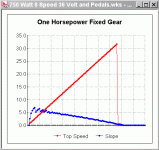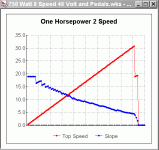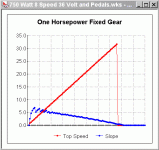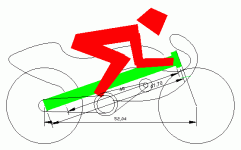To my simple mind this is what I've concluded from the great debate of gears vs fixed.
 Hub motors have a useable wide bandwidth,
Hub motors have a useable wide bandwidth,
so they can get away without the need for any gears.
 Gears do help out with efficiency but at most all you need is two.
Gears do help out with efficiency but at most all you need is two.
(no need to read any further, the rest is just there to back-up these statements).
Actually this holds true for most electric motors, but BL hub motors are optimized to be broader than most.
By bandwidth I'm referring to their relatively flat, broad power band as shown in this graph.
Bandwidth is defined as the the two end points at which the power level has dropped by 50% off it's peak point. This applies equally to any kind of power, audio power from an amp, optical power from an LED or LASER, etc.
In this graph, ignoring everything except the black power(out) curve, the peak is 80, so cutting off at the 40 end-points it ranges from (I'm presuming 5mph div?) 12mph to 47 mph giving a useable bandwidth of 35mph. (mph being a stand-in for wheel rpm)
Now compare the bandwidth of this motor with gearing.
It's bandwidth is 45 mph, a gain of 10 mph or almost 30%. Not at all insignificant, but not earth shattering either. The hub motors curve is already pretty close to that perfectly flat ideal, but not completely flat. Anyone who has driven an ebike for any length of time can relate that this statement is perfectly true:
safe said:
If the fixed geared bike is geared to attain the maximum top speed it loses low end torque.
If the fixed geared bike is geared for torque it loses top speed.
The obvious conclusion is that all that's required is a hi/lo gearing setup.
Because the hub motor is flatter (compared to something like an ICE) or basically it's flat enuf, at most all you need is two gears to shift that broad band either up or down slightly & you've got the total rpm range covered. Anything more than two is redundant as is borne out by some of the best engineering minds that have determined that the Tesla only come with two speeds.
Having two gears
would be nice to have but the question becomes, how much is that extra 30% worth & what does it cost to achieve it. Especially from the manufacturers standpoint where the upper limit of the bandwidth is capped at 20mph by regulation. With that cap the gearing advantage drops down to only 5mph & that remaining bit can be somewhat made up for by shifting the power peak downwards with modification of the controller & motor design. To a manufacturer building the hub motor oversize to compensate is preferable because it saves steps in the assembly process with a lower total parts count & that saves money all along the production & distribution chain. Fewer parts mean fewer things to go wrong & less parts to stock.
The way I look at it is that gears are not desireable, they are a necessary evil. You include them only if you can't get the job done without them. The performance requirements for an ebike are so modest that the powerband of a hub motor ju-u-u-st barely stretches wide enuf to cover the full envelope as is, without gears. Unless you do a lot of hills, you spend such a small percentage of time of your overall driving profile in that lower portion where it's deficient that it's a reasonable compromise to save on cost, weight & complexity. Even for hills, the design of the motor can be optimized as the various flavours of Crystalite do this.
In eletrical terms I view a transmission as an impedance matching network like an electrical power transformer, as are any of the basic machines such as the lever. They convert something you have in abundance to something you need which you are lacking. Typically for a small motor you have plenty of rpm but not a lot of torque, so gears match the load to the power source, converting its high rpm/low torque to high torque/low rpm at the output of the transmission.
Building a hub motor oversize to
adequately cover all the bases is cheaper/simpler than a small motor with transmission to do an
ideal job of it. Yes, the oversize hub comes with an efficiency hit, but put it this way;
 If you're able to move a heavy rock by muscle power alone you don't automatically reach for a lever every time, even though it would be considerably easier & more efficient to do so.
If you're able to move a heavy rock by muscle power alone you don't automatically reach for a lever every time, even though it would be considerably easier & more efficient to do so.
The great debate seems to be geared towards (pun intended) an unreality of getting out the absolute ultimate '
ideal' in performance which may be the case in the rareified atmosphere of motorcycle racing but not for the majority of typical users. In that situation multiple gearing of an electric motor does serve a purpose.
Like an ICE, the human motor is very 'peaky', ie. narrow bandwidth. What the 21 or 27 gears do for you is shift that very narrow power band up & down across the rpm range which reqiures a lot of ratios to cover the whole band with a bunch of narrow power band 'slivers'. An Electric motor with its wider power band obviously doesn't require as many ratios.
'Safe' has come to realize that a transmission designed for the human motor is unsuitable for an electric motor & needs a wider spacing. The wider spacing is an acknowledgement of the electric powerplant's wider bandwidth. His transmission has dropped from 12 gears to 6 & if he keeps going, he will ultimately arrive at the same conclusion everyone else has; that you only need two speeds, a high & a low for puttering around town.
Now for racing there is benefit for some additional gears. The power band of the hub motor while relatively flat is not perfectly flat, there is a peak point. Gearing would shift that peak along over the rpm range giving you an ever finer 'ripple' of multiple peak points the more ratios you have. But that peak is shifting largely in the region that was already covered within the 50% cutoff of the fixed drive so the benefit is minimal, but yes very real.
To gain that small benefit, the question again at what cost, how many gears do you want to carry around? The ultimate for a perfectly flat power curve would be a CVT. Even at that, the difference in performance is primarily in efficiency & the (relatively) small difference
will manifest after hundreds of laps in a race where small differences make all the difference in winning by a narrow margin. How many of us need ultimate performance all the time?
For day-to-day riding, the efficiency gains of even a CVT hooked to an electric motor may turn out to be just barely noticeable. I fear that people might have too high an expectation of the performance enhancement a CVT will bring to an electric drive system. The electric motor is pretty good already on its own. You're largest gain in performance comes after adding your first gear ratio. After that it's all diminishing returns.
That is my summation of 28 pages of dialog passed thru my own filter of understanding & experience. I've been waiting for someone smarter than I to step up & do it. Didn't look like that was gonna happen & don't need it drag on for another 28 pages. Forgive me if it seems like I'm dumbing it down as that's not the case. Like I said, it's how my simple mind makes sense of it.
Have I got it strate?
Is the debate over?
Do I 'win'?
Whaddaya say we lock this thread & throw away the key?
My two gears worth.
 Gearing will always dominate whenever a FIXED POWER (one horsepower in this case) is the defining parameter.
Gearing will always dominate whenever a FIXED POWER (one horsepower in this case) is the defining parameter.












